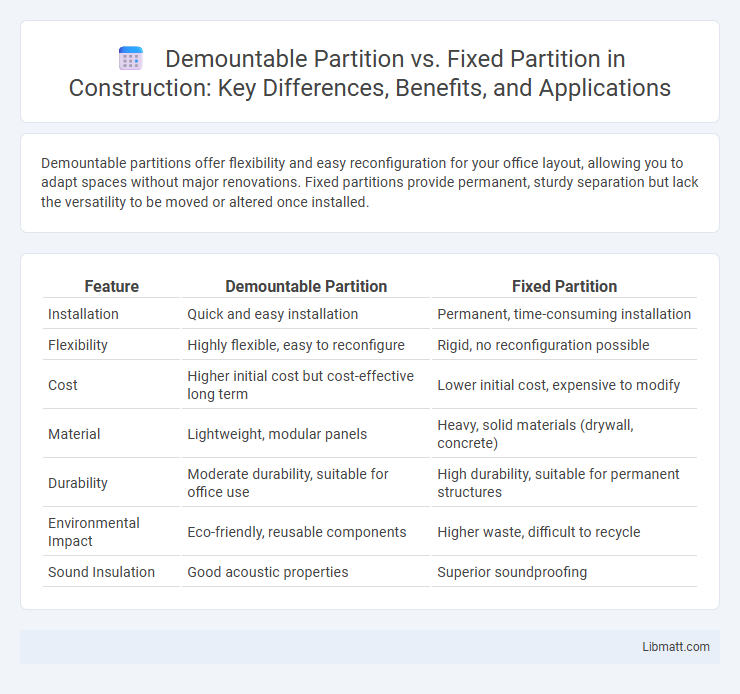Demountable partitions offer flexibility and easy reconfiguration for your office layout, allowing you to adapt spaces without major renovations. Fixed partitions provide permanent, sturdy separation but lack the versatility to be moved or altered once installed.
Table of Comparison
| Feature | Demountable Partition | Fixed Partition |
|---|---|---|
| Installation | Quick and easy installation | Permanent, time-consuming installation |
| Flexibility | Highly flexible, easy to reconfigure | Rigid, no reconfiguration possible |
| Cost | Higher initial cost but cost-effective long term | Lower initial cost, expensive to modify |
| Material | Lightweight, modular panels | Heavy, solid materials (drywall, concrete) |
| Durability | Moderate durability, suitable for office use | High durability, suitable for permanent structures |
| Environmental Impact | Eco-friendly, reusable components | Higher waste, difficult to recycle |
| Sound Insulation | Good acoustic properties | Superior soundproofing |
Introduction to Partition Systems
Demountable partition systems offer flexible space management by allowing easy installation, reconfiguration, and removal without major structural changes, unlike fixed partitions that are permanent and require significant construction. Your choice depends on factors like budget, timeline, and future space adaptability, as demountable partitions reduce waste and downtime. These systems are ideal for dynamic environments needing customizable layouts while fixed partitions suit long-term, stable designs.
Overview of Demountable Partitions
Demountable partitions are modular wall systems designed for easy installation, relocation, and reconfiguration, offering flexibility in office layouts compared to fixed partitions. They consist of pre-engineered panels made from materials such as glass, metal, or gypsum board, enabling efficient space utilization and reduced construction waste. This adaptability supports sustainable building practices and cost-effective long-term interior design solutions.
Overview of Fixed Partitions
Fixed partitions consist of permanent walls constructed with materials like drywall, concrete, or brick, offering robust structural separation in interior spaces. These partitions provide enhanced sound insulation, fire resistance, and security, making them ideal for long-term, unchanging layouts. However, their inflexibility limits adaptability, as modifications require significant time, cost, and construction efforts.
Installation Process: Demountable vs Fixed
Demountable partitions offer a faster and less invasive installation process compared to fixed partitions, as they can be assembled and reconfigured without major structural alterations. Fixed partitions require substantial construction work, including demolition and rebuilding, which increases installation time and costs. The modular design of demountable partitions enables easier adaptability to changing office layouts, minimizing downtime during installation.
Cost Comparison: Initial and Long-Term
Demountable partitions typically offer lower initial costs due to easier installation and reduced material expenses compared to fixed partitions, which require more time and labor. Over the long term, demountable partitions provide greater cost savings through flexibility and reusability, allowing you to reconfigure office layouts without significant renovations. Fixed partitions, while durable, incur higher long-term costs related to demolition, disposal, and reconstruction when changes are needed.
Flexibility and Adaptability
Demountable partitions offer superior flexibility and adaptability compared to fixed partitions, allowing spaces to be reconfigured quickly to meet evolving office or commercial needs. Unlike permanent fixed partitions, demountable systems can be dismantled, relocated, and reused without extensive renovation costs or downtime. This makes demountable partitions ideal for businesses seeking dynamic and scalable workspace solutions.
Acoustic and Privacy Performance
Demountable partitions offer superior acoustic insulation compared to fixed partitions, featuring sound-dampening materials and seals that significantly reduce noise transmission, enhancing privacy in shared workspaces. Fixed partitions, typically made from solid materials like drywall, provide excellent soundproofing but lack the flexibility and adaptability of demountable systems. Your choice depends on whether you prioritize long-term acoustic performance or the ability to reconfigure spaces with maintained privacy.
Maintenance and Durability
Demountable partitions offer easier maintenance due to their modular design, allowing individual panels to be replaced or repaired without major disruption. Fixed partitions typically provide greater long-term durability owing to robust, permanent construction materials like drywall and metal studs. Maintenance costs for demountable systems tend to be lower, while fixed partitions often require more extensive upkeep after damage.
Environmental Impact and Sustainability
Demountable partitions significantly reduce environmental impact by promoting reusability and minimizing construction waste compared to fixed partitions, which often require demolition and disposal. You can enhance your workspace sustainability by choosing demountable partitions, as they conserve resources and decrease landfill contributions. These flexible systems also support LEED certification efforts, making them a preferred eco-friendly option in modern office design.
Choosing the Right Partition for Your Space
Demountable partitions offer flexibility with easy installation, reconfiguration, and sustainability, making them ideal for dynamic office environments or spaces requiring frequent layout changes. Fixed partitions provide durability and superior sound insulation, best suited for permanent divisions in commercial or residential buildings. Selecting the right partition depends on balancing long-term space needs, budget constraints, and acoustic requirements to optimize functionality and aesthetic appeal.
Demountable partition vs fixed partition Infographic

 libmatt.com
libmatt.com